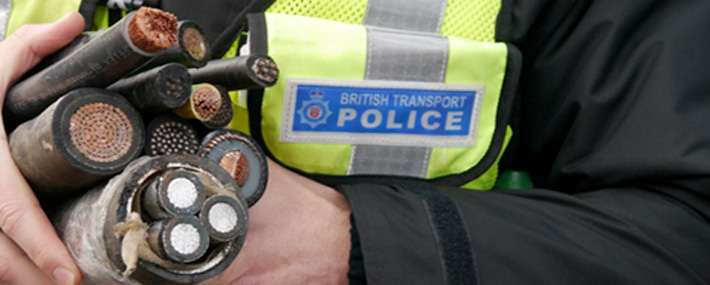At its peak, cable theft was estimated to cost the UK economy £770 million per year. Even though a £5 million funded crackdown from British Transport Police (BTP) has helped dramatically reduce the level of cable theft, in the first half of this financial year, (up to 14th September 2013) there has been 95 incidents of cable theft within the UK’s rail network alone. Causing 30,928 minutes of delays and an estimated compensation cost of over £1 million.
These figures do not include the cost of staff time to repair and replace the stolen cable, replacement of the cable itself and the cost of extra security measures implemented to try to prevent future thefts. The total cost of these measures in the 12 months up to April 2013 reaching £12.7 million.
Causes Behind Cable Theft
It’s easy to see why cable theft has seen an increase in the past decade up to its peak, with the price of copper soaring since 2002. From £1000 to around £6000 per metric tonne at its peak.

With copper becoming so valuable and with its abundance within rail networks, copper theft via cables spiralled out of control.
Combatting Cable Theft
There are a number of methods than can be implemented to help fight cable theft.
Existing Technologies
 Ellis Patents Tamper Proof Cable Cleats – Ellis’s tamperproof cleats are designed to make removing copper cables almost impossible. Its box design makes the task of detaching the cleat from the cable as difficult and as time consuming as possible.
Ellis Patents Tamper Proof Cable Cleats – Ellis’s tamperproof cleats are designed to make removing copper cables almost impossible. Its box design makes the task of detaching the cleat from the cable as difficult and as time consuming as possible.
This added to the requirement (for short-circuit protection) to fit cleats at regular intervals along the length of the cable means thieves will simply not have the time to remove the cleats, and therefore the cable, in time before the authorities arrive.
RedWeb Technologies – Working alongside the BTP, RedWeb Security have designed an indelible fluid that’s applied to the surface of cables. The spray will transfer to skin, clothing or hair of the thief and remain detectable for over 6 months.
Each batch of spray contains a unique forensic code which is traceable to the location of where it was applied to the metal. By glowing bright red under a UV light, signalling the suspected criminal had an involvement with the theft by being contaminated with the dye.
SmartWater – Similar to RedWeb’s forensic fluid, Smartwater asigns trackside cables with a uniquely coded chemical signature that is identifiable by police. The liquid is almost impossible to remove and can even withstand burning. Once detected the Smartwater provides the police with irrefutable proof of involvement with a particular cable theft. It has been proven to cut cable theft on key national rail routes.

Anti-Vandal Guards – These galvanised steel anti-vandal guards provide protection from vandalism and theft. Designed primarily for 25x3mm earthing tape, the guard is also suitable to secure and protect smaller cable systems. Easy to fix and with long lasting corrosion resistance, it is a further deterant to copper cable theives. Please contact us for price and availability.
New Legislation
The new Scrap Metal Dealers Act has now come into force, making it harder for metal thieves to sell on stolen metal. Replacing the 1964 act, it requires all dealers to have a licence, which it makes tougher to get, as well as requiring sellers to provide ID at the point of sale and have it recorded by the dealer.
It is hoped the new traceability deters criminals from carrying out copper theft.
These preventative technologies and innovations, along with tougher legislation and police crackdowns have helped reduce cable theft from its peak. Time will only tell whether or not this new scrap metal law will have the desired effect, however we believe the combination of these tactics, although incurring additional costs, will be beneficially in the long run compared to downtime, replacement cable and labour costs. Learn more about our offer of power cable lugs.
Video: Cable Thefts Reach Crisis Point
If you found this article helpful or interesting, please share it!













